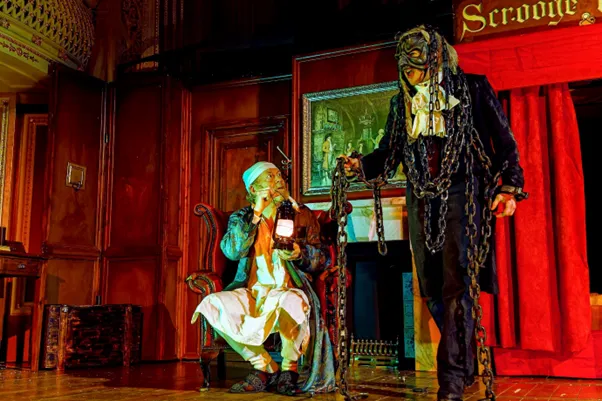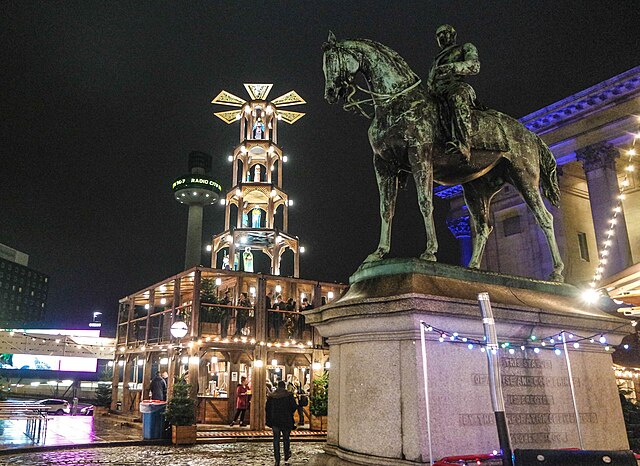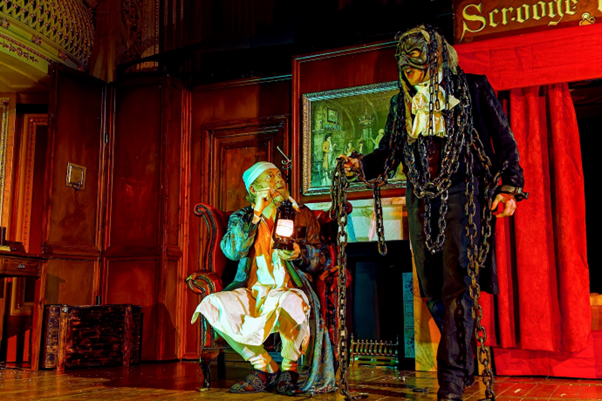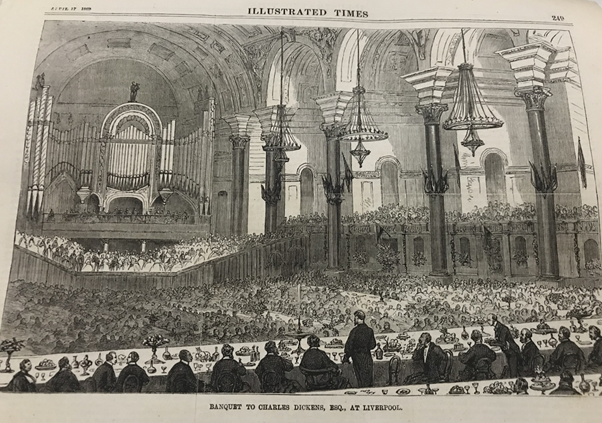A Christmas Carol at St George’s Hall: Boz tha, or bleak Scouse?

We sent The Post’s resident miser to see if three Christmas ghosts might change his attitude
God help us — another rendition of A Christmas Carol.
“While the word Dickensian lasts,” VS Pritchett once wrote, “The English novel will be suffocated.” The great Victorian author squats with proprietary weight over late December, too. A Christmas Carol’s ubiquity makes Dickens’s formidable door-knocker beard almost as synonymous with the season as Father Christmas’s: deadlier than mistletoe, ready at an instant to wrap like a strangling vine around an unsuspecting reveller and subject them to another cloying caricature of London society. The man even gets credit for inventing Christmas itself.
I approached writing this piece with trepidation, having been raised under the orthodoxy that Alastair Sim’s 1951 portrayal of Scrooge would forever be peerless — although, since marrying, I’ve become aware of a heresy involving Michael Caine and some fabric marionettes. In any case, surely the matter of the “best” Scrooge is long-settled, and other actors need not apply. But fearing any suspicion of humbuggery more than my own boredom, I accepted my assignment and made my way to St George’s Hall for Ginificent’s festive adaptation.
The grand neoclassical parthenon is, one must admit, the perfect setting for A Christmas Carol. Although Dickens is undoubtedly a – perhaps the – London novelist, his Liverpool associations are numerous and underreported. Anyone who has walked past the Bridewell on Campbell Square (once a Victorian gaol, now a labyrinthine pub) may have spotted a plaque commemorating the writer’s one-night stint as a special constable with this city’s police force. But it was at St George’s Hall where he would see his popularity in Liverpool peak. In 1866, demand to hear Dickens read in person was so great that an estimated 3,000 people had to be turned away.
Strolling beneath St George’s Corinthian pillars 158 years later, among the nocturnal lights of Liverpool’s Christmas markets after begrudgingly forking out eight whole English pounds for a glorified hotdog, it occurs to me that there’s no accounting for taste. Because who was Dickens, anyway? Wasn’t he just another sentimental, sexist Victorian, morbidly preoccupied with melodrama, distinguished from his contemporaries only by his whimsical moralising and bourgeois crocodile tears over poverty-stricken urchins, wise only in that he spared Tiny Tim the maudlin demise of Little Nell that famously sent Oscar Wilde into spasms of laughter…

But by the time we take our seats, I’m feeling better disposed to the event. The stage design, smartly incorporating Scrooge & Marley’s offices with our skinflint hero’s canopy bed and the London skyline, fits wonderfully into the concert room’s neo-Grecian finery. Director Clare Scott is to be commended: the lighting is moody, the music and sound design not too ostentatious, and, as the play unfolds, the acting earnest. A little Grand Guignol, perhaps, but A Christmas Carol is a bit like a good beef joint – even if you’ve slightly overcooked it, it’s still very digestible with all the trimmings, unlikely to cause nocturnal hallucinations. GK Chesterton, in his study of Dickens, observed that the atmosphere is often more important than the story, and Ginificent’s production achieves this with aplomb.
Despite my prejudice against yet more Carolling, the intelligent staging, in tandem with the eight actors’ clever doubling up on roles and splendid costumes (the massive Ghost of Christmas Future must be seen to be believed), gradually won me round. If the pre-interval section up to the Ghost of Christmas Past felt a little slow, the much longer second part flew by as the cast and crew turned up the charm and the exuberance.
And what of Scrooge himself? Does seasoned television and stage actor Ken McConnell, hailing from Liverpool, trouble Sim’s pre-eminence? The best Scrooges are not ones that invite that comparison. Attempting to match Sim’s bipolar extremities is the wrong way to play the character – only an actor of his flamboyance and dignity could get away with it. As Chesterton observed, Scrooge is no more inhuman at the beginning of the story than at the end – his Malthusian barbs against charity and overpopulation are infused with the same humanity that inspires his redemption, and the challenge for the actor is to bridge the two sides of the man’s soul. McConnell ably ploughs this thoroughfare, ensuring old Ebenezer is still recognisably the same person by the story’s close, transformed but not replaced by his hauntings.

To enjoy A Christmas Carol is to likewise surrender to it — to allow the spirits to ignite your humanity as they do Scrooge’s. Living in an era so beset with rapacious greed and social iniquity it may as well be called Neo-Victorian, perhaps what we actually need is more Dickens and not less.
Leaving St George’s, I couldn’t claim to be converted, Scrooge-like, to year-round goodwill, but the magic of A Christmas Carol done well, with the heart and vivacity this adaptation manages, is too potent to wholly resist. Perhaps the Ferris wheel lights looked a little softer, the carousel music somewhat gentler, the so-called currywurst good value after all. (Alright, maybe not that last one.)
In 1869, St George’s Hall held a farewell banquet to honour Dickens, his work, and his 30-year bond with Liverpool. The author, who had previously described the venue as “the most perfect hall in all the world”, took the opportunity to extoll not only the hall’s virtues but the city’s, proposing a toast: “inseparable from the public enterprise of Liverpool, the public honour and public spirit of Liverpool, inseparable even from this great hall, equally inseparable from the stately streets and buildings around us, and from the hospitals, schools, libraries, all those great monuments of consideration for the many.”

Just as he saw Liverpool’s architecture united with its public spirit, Dickens’s own enthusiasm for life and appreciation of grandeur were inextricable from his social conscience. It was not dewy-eyed crowdpleasing, but Dickens’s genius for seeing the continuity between individuals, their everyday lives, and the churning engine of societal forces that imbued Scrooge’s story with its enduring relevance. A Christmas Carol may be a London novella, but its marriage of the grand, the good, and the garrulous – a combination worthy of the term “Dickensian” as any East End workhouse – makes Liverpool an appropriate host, especially now it has earned the title of the UK’s most generous city. If we could only rid ourselves of its weakness for commercialism, the encroaching sense this time of year of being gouged at a faux-Bavarian stall or crowded by the queues at every shopping centre till, we might live up to Dickens’s hopes for us and for humanity. Ah, well. God bless us, Liverpool One.
A Christmas Carol at St George’s Hall is running until 29th December. You can purchase tickets here.

Comments
Latest
The council takes back Toxteth streets. But why were they given away in the first place?
The men who raised the flags
On the Wirral, public trust goes up in smoke
Gerard Woodhouse pleads guilty to harassment. “Jail him,” says his victim
A Christmas Carol at St George’s Hall: Boz tha, or bleak Scouse?
We sent The Post’s resident miser to see if three Christmas ghosts might change his attitude